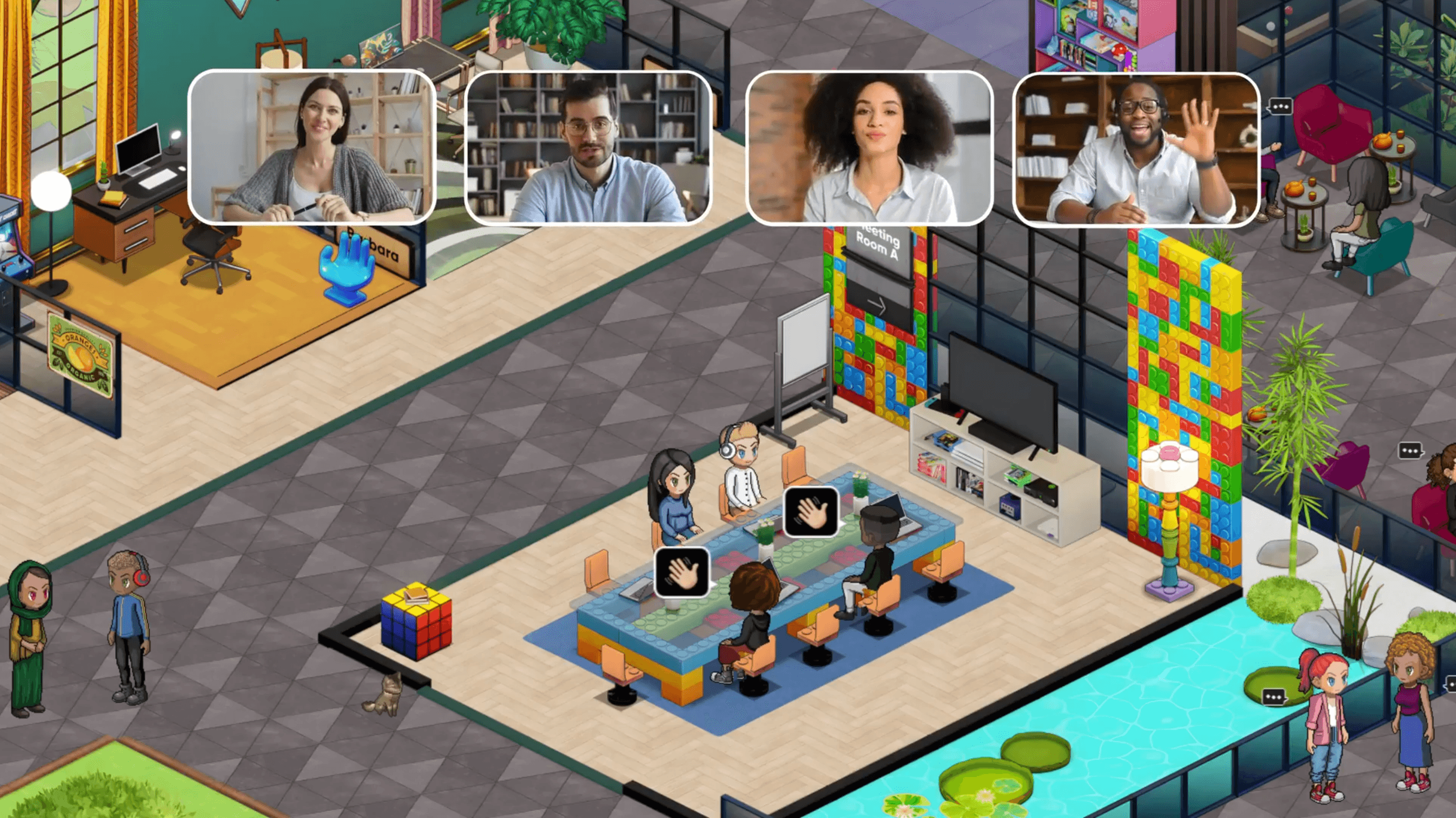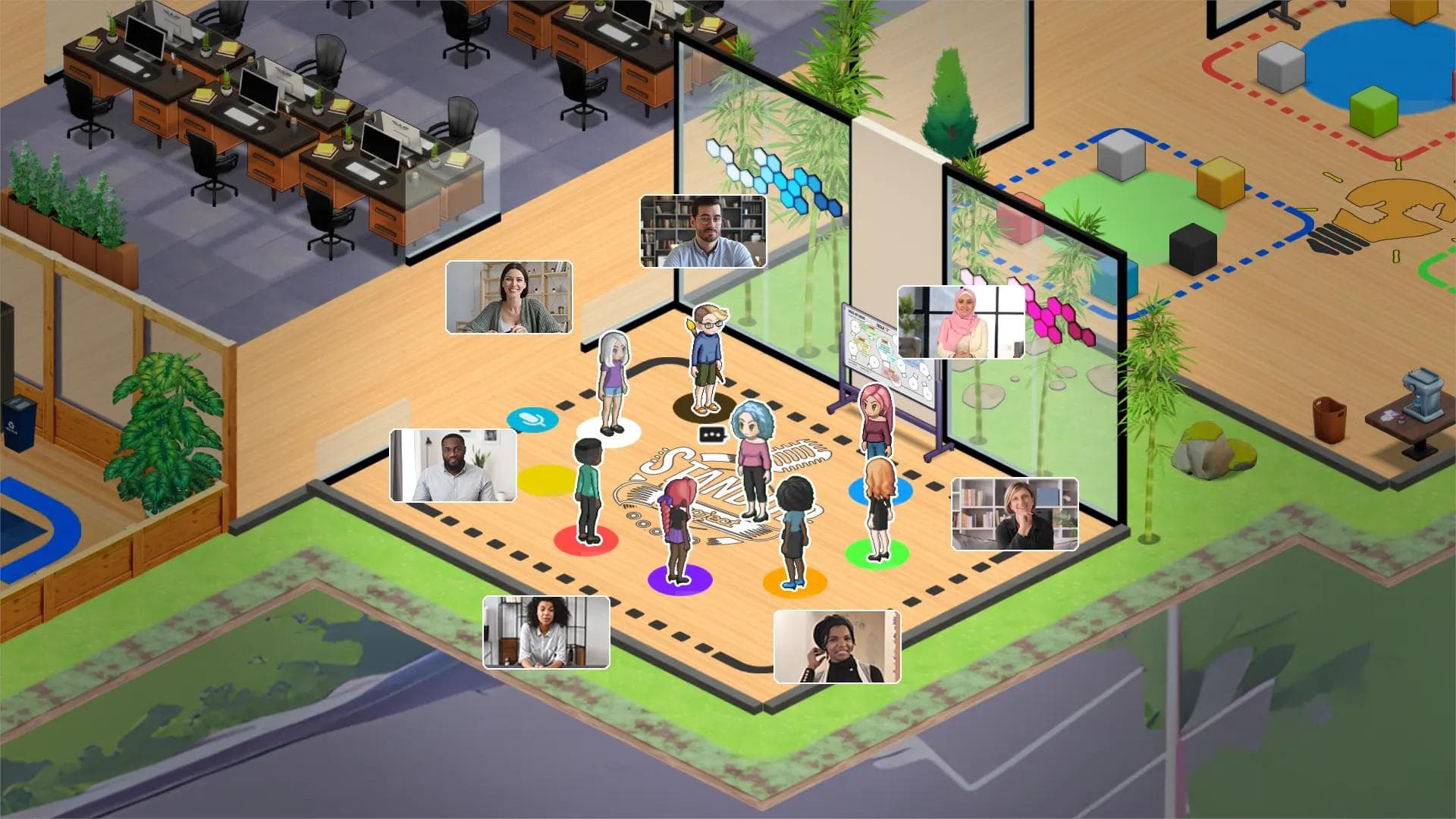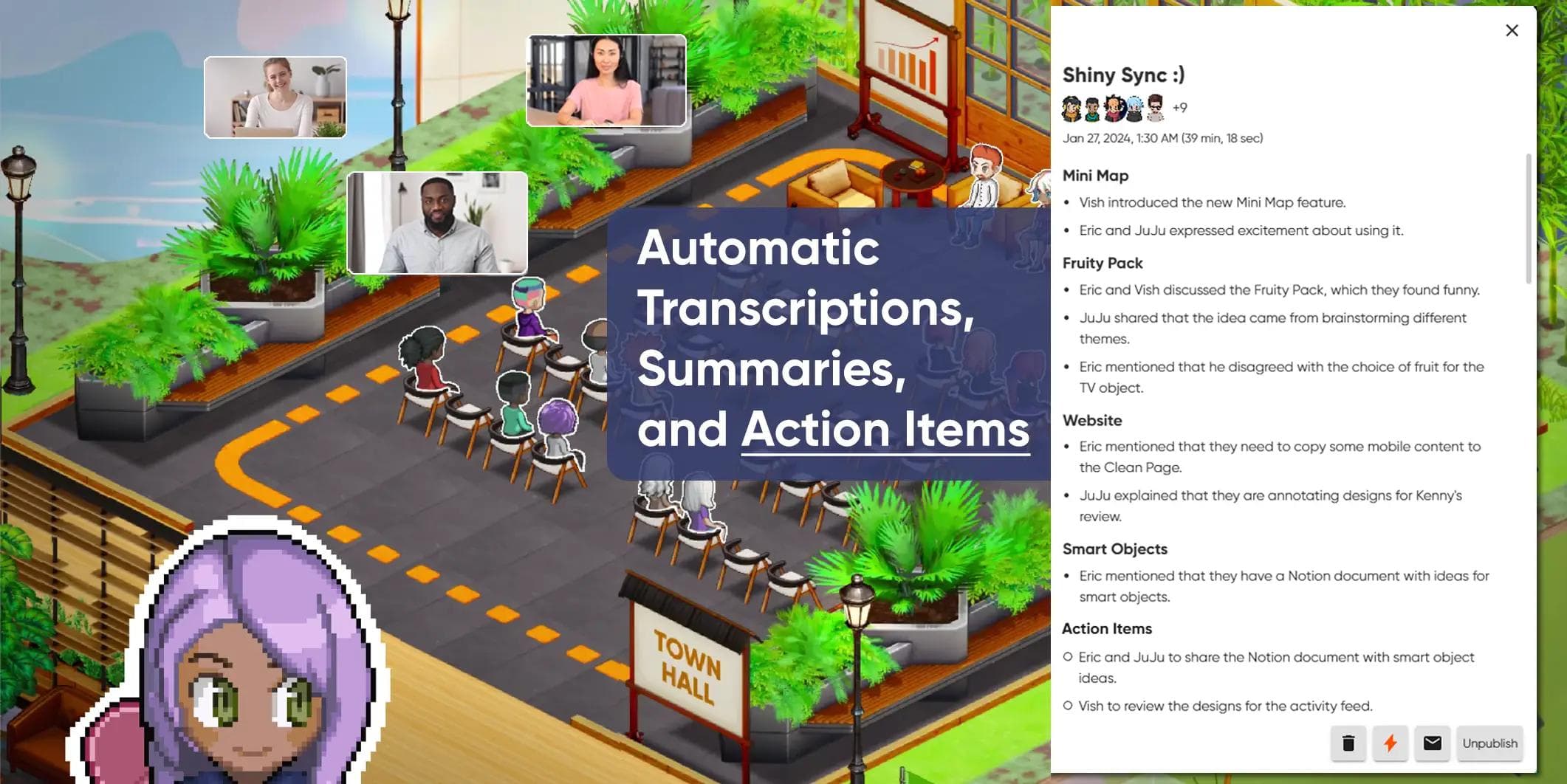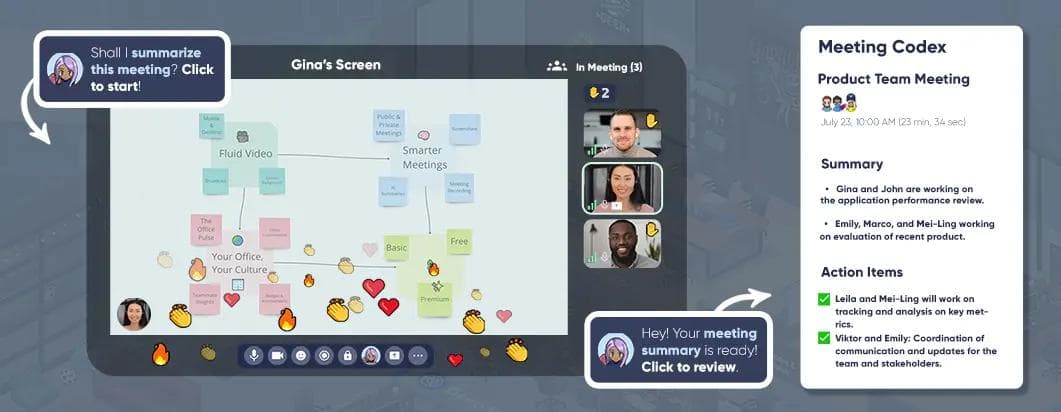What Are Staff Meetings?
Staff meetings are regular company-wide meetings. They're typically led by the CEO, founders, or team leader.
The purpose of these meetings is to keep an entire team aligned. They focus on sharing updates, discussing current issues, brainstorming solutions, and coordinating actions related to company goals and objectives.
Successful staff meetings clarify company direction, align employee efforts, enhance teamwork, and improve overall organizational performance.
6 Staff Meeting Topics to Try
1. Review and Create Goals
Purpose
Make sure the entire company is on the same page about what the company goals are. Set employees up to align their own work to achieving these goals.
Why it works
This topic clarifies expectations and enhances accountability to company goals by ensuring everyone is focused on the same destination and knows the path to get there.
Running this staff meeting with a remote team?
- Take the meeting in a virtual workplace (e.g. SoWork) instead of a traditional video conferencing tool (e.g. Zoom). This will boost engagement with the meeting.
- Make goal review interactive! Set up a goal meter for the team to find during the meeting.
- Break off into groups when it's time for employees to share personal goals. If you're using SoWork, groups can take advantage of proximity meetings. Just walk away from the main meeting and form a new meeting nearby. Use the announce feature to let groups know when it's time to re-join the main meeting.
- Try SoWork's Staff Meeting template
Ideas for the meeting
- Begin the meeting with a review of current team objectives and how they align with company priorities. This will ensure everyone is on the same page about what counts as a win.
- Allocate time in the meeting for discussing progress, addressing roadblocks, and celebrating milestones related to team goals. This will boost employee buy-in to achieving company goals.
- Facilitate a group exercise during the meeting where employees can set personal goals that will help drive the company's goals. Have employees share these goals. This will clarify how everyone's work drives company goals, and increases accountability to achieving them.

2. Celebrate Success
Purpose
Boost morale and increase employee engagement. Incentivize work that is aligned with company goals.
Why it works
Employees feel appreciated when their success is recognized, especially in public forums. And because we reinforce whatever we celebrate, choosing to highlight work aligned with company goals helps reinforce goal driving as a priority.
Running this staff meeting with a remote team?
- If you're using a virtual workplace like SoWork, add a celebratory vibe to the meeting. Use the mapmaker to add balloons and photos of what's being celebrated.
Ideas for the meeting
- Designate a portion of the meeting for sharing specific goal-driven achievements and explaining their impact on the team or organization.
- Include a "peer appreciation" segment in the meeting agenda. Team members can nominate their peers for recognition (before the meeting) and share anecdotes of their goal-oriented contributions.
- Incorporate interactive activities, such as awards or team quizzes, into the meeting to celebrate goal accomplishment in a fun and engaging way. If you're using SoWork, you can give an employee an award live in the meeting!

3. Collaborate Cross-Functionally
Purpose
Break down siloes. Get employees engaged with achieving goals. Solve challenging problems.
Why it works
Employees have valuable perspectives and insights on challenges across the organization. They are more engaged with goal achievement when these perspectives are sought after. And, bringing different teams together to collaborate on the biggest organizational challenges and opportunities increases success.
Running this staff meeting with a remote team?
- Using a virtual workplace like SoWork? Set up themed corners of the office that focus on a specific problem or opportunity. Add a sign to signal what the topic is. Embed a document that covers important context. Give each topic zone a whiteboard to document their thoughts.
- After each team has finished brainstorming, go to each topic zone together as a group and see what the teams came up with.
Tips
- Invite speakers from different departments to your staff meetings to share updates, insights, and untold stories. This fosters cross-functional understanding of what each part of the company is focused on.
- Incorporate team-building exercises or icebreakers that encourage interaction between employees from different departments during the meeting. This will help foster a collaborative environment across teams.
- Use staff meetings as a platform for brainstorming joint initiatives or projects that address shared challenges. This taps into employee perspectives and allows teams to solve big problems together.

4. Brainstorm
Purpose
Give employees an opportunity to get creative and share ideas.
Why it works
Most days are focused on execution. Many employees have a lot of untapped creativity and ideas. By creating a focused forum around ideation, employees can express their creativity and the team can get great ideas for important problems.
Running this staff meeting with a remote team?
- If you're using a virtual workplace like SoWork, set up ideation stations before the meeting. Create themed zones with whiteboards, embedded objects with context or idea starters, and add the names of teammates to each zone.
- Use the announce feature to communicate with everyone during the meeting.
Tips
- Start the meeting with a short game or icebreaker question to get everyone warmed up.
- If you have specific areas you want teams ideating around, share those before breaking off into groups. Explain why the problem or opportunity is to exciting.
- Make sure teams know what to do when they get to their zones. Walk from zone to zone to make sure everyone is unblocked to get creative and ideate.

5. Take Questions
Purpose
Give employees a chance to openly ask leadership questions. Give leadership insight into what is most on the team's mind.
Why it works
A staff meeting dedicated to asking questions gives employees a communication pipeline to leadership. Getting these questions answered by leadership gives employees important context and develops buy-in with company decisions. Leadership also gets insight into confusions, misalignments, and opportunities.
Running this staff meeting with a remote team?
- If you're using SoWork, get a summary of the meeting. This allows employees to review answers and leadership to follow up on topics raised.
- Click the record icon in a meeting and toggle the summary button. At the end of the meeting you'll get an AI-generated meeting summary with action items.
Tips
- If your team hasn't done open questions before, set the tone at the start of the meeting. Let everyone know that all questions are welcome and will be greeted with respect. Some questions may not be able to be answered, but leadership will do their best to provide any information they can.
- Have a member of the team come prepared with a relevant question. If no one is asking anything at the start of the meeting, this person can ask their question to kick things off.
- Example questions:
- What are you most concerned about right now? What are you least concerned about?
- What is holding us back from achieving our revenue goals?
- What will our growth strategy be next quarter?

6. Build Company Culture
Purpose
Improve employee connection to company values by celebrating examples. Strengthen company culture.
Why is works
We reinforce what we recognize, especially publicly. Celebrating examples of employees modeling company values is a great way to a) remind everyone what matters culturally on the team, and b) show real examples of what it looks like.
Running this staff meeting with a remote team?
- Get employees to set up teammate recognition signs before the meeting. They can add images, quotes, or data that tell the story. In the meeting, walk over to each recognition sign together and tell the story.
- Add a suggestion box for employees to add additional ideas on culture building after the meeting.
Tips
- Review the company values in an engaging way. Tell stories from around the organization of company values in action.
- Involve the team! Let them speak about the values in their own language.
- Share stories where specific individuals modeled company values. Make sure the modeling of the values is tied to a positive impact that you want to reinforce. Like achieving a goal or overcoming an obstacle.
- Involve team members in shaping and evolving the company culture by encouraging them to share their ideas for specific actions the company can take to reinforce its culture and values.
Develop a Follow-up Process
Lack of follow-up on action items, ideas, or employee feedback can make future staff meetings seem less meaningful.
Establish a process for notetaking, action item tracking from discussions and feedback, and acting upon the outcomes of the meeting.
In SoWork, you can use our AI-powered meeting assistant to:
- Take notes
- Generate summaries and action items
- Share them with the team after the meeting
This commitment to continuous improvement will increase the value of the all-hands meeting and encourage future engagement.

Wanna Try Your Meeting in SoWork?
SoWork is an immersive virtual workspace where teams around the world take engaging, productive meetings every day.
- Create a free office using our Staff Meeting template
- Follow the steps to invite your team
- Walk up to each other to connect to a meeting
- Enable the AI meeting assistant to take notes and summarize your skip level meeting
- Follow your ready-to-use questions from this page to drive a successful skip level meeting
- When you're done, our AI meeting assistant will give you a summary and action items
That's it! Good luck with your next Staff Meeting.